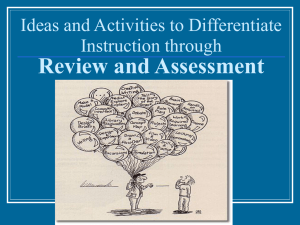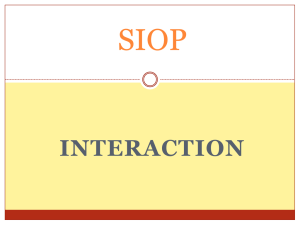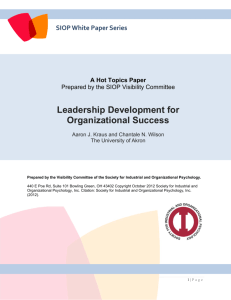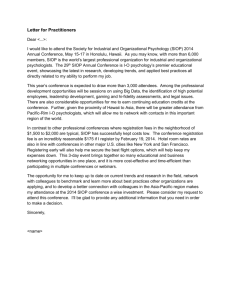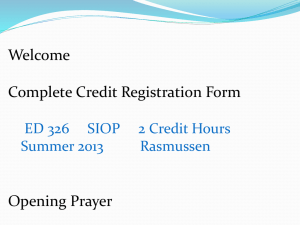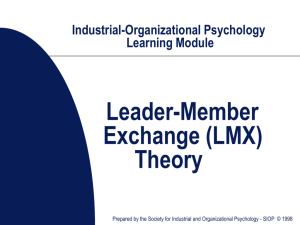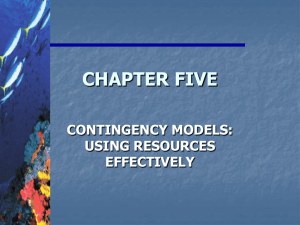Improving Communication in Virtual Teams
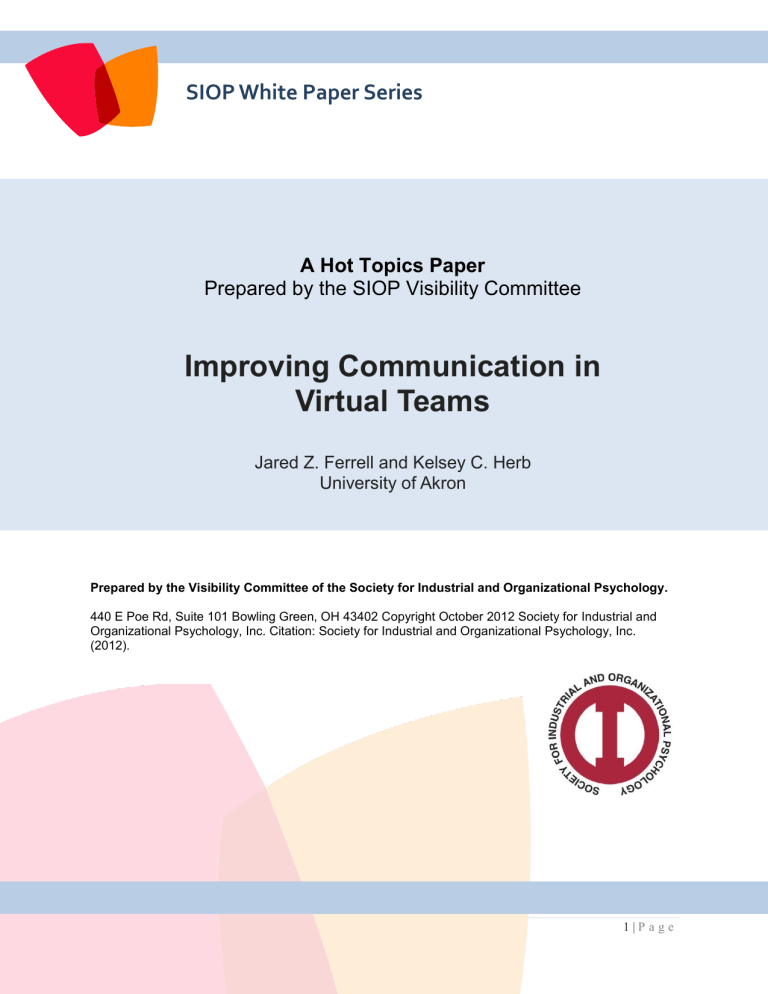
\
SIOP White Paper Series
A Hot Topics Paper
Prepared by the SIOP Visibility Committee
Improving Communication in
Virtual Teams
Jared Z. Ferrell and Kelsey C. Herb
University of Akron
Prepared by the Visibility Committee of the Society for Industrial and Organizational Psychology.
440 E Poe Rd, Suite 101 Bowling Green, OH 43402 Copyright October 2012 Society for Industrial and
Organizational Psychology, Inc. Citation: Society for Industrial and Organizational Psychology, Inc.
(2012).
1 | P a g e
SIOP White Paper Series
Communication is an integral component of success for any team.
Strong interpersonal communication has been associated with such valuable outcomes as increased trust, commitment to the workgroup and organization, shared expertise, and ultimately improved performance. Organizational functioning is dependent upon the communicative relationships among individuals within that organization because these relationships facilitate the dissemination of critical information and expertise that enables high performance
4
.
As such, organizations should strive to facilitate effective communication methods. The importance of enabling communication is even more pronounced when considering the functioning of virtual teams, which comprise members who rarely, if ever, interact face-to-face.
Rapid technological advancements as well as changing global demands, over the past two decades, have changed the nature of work within organizations
2
. Advances in communication technology have allowed organizations to become more flexible, as employees can conduct work from home
5
and even communicate across remote geographical distances
3
. One major advantage of such a process is that it allows organizations to leverage diverse skills and abilities that are unlikely to be found in one location
2 . As technology facilitates such changes, “virtual” teams are becoming increasingly prevalent in organizational structure.
With the recent surge in utilization of virtual teams in organizations, it has become imperative to understand how communication networks develop in virtual team contexts and the factors that facilitate effective functioning. Communication networks are essentially the patterns of interpersonal contact through which information is shared within an organization or workgroup
8
.
Through interactions with colleagues, individuals develop vital relationships that enable communication networks to develop. Similar to any form of social network, communication networks are the pathways through which information is shared. Social connections within the network lead to both formal and informal sharing of vital knowledge and information that can enhance team functioning. Virtual teams, however, lack the richness of interaction opportunities that are afforded to face-to-face teams. Ostensibly, this puts virtual teams at a disadvantage in
2 | P a g e
SIOP White Paper Series how information and expertise are shared among members. Fortunately, there are ways of influencing how individuals interact and communicate within teams. Three major factors affecting knowledge sharing in virtual teams are trust in team members, leadership, and the communication technology employed. As such, organizations can facilitate the development of strong virtual team communication networks by appropriately leveraging these factors.
At the core of nearly every model of knowledge dissemination within virtual teams is trust in other members
10
. One potential barrier to knowledge sharing among members of virtual teams is the fact they are more vulnerable to mistrust than face-to-face teams.
There are different reasons for this increased potential for mistrust to develop in the early stages of virtual team formation, including lack of formal introduction to team members, lack of geographical proximity of certain members to others, and the fear of
At the core of nearly every model of knowledge dissemination within virtual teams is trust in other members
10
.
having comments unduly criticized by other team members with whom one has not had the opportunity to build an in-person relationship. This potential for mistrust is a barrier that virtual teams must overcome in order to create a highly communicative environment that promotes knowledge sharing
10
.
There are numerous methods that can be utilized to increase trust among virtual team members. Face-to-face orientation meetings are one way to encourage the recognition of team members as knowledgeable and trustworthy individuals, as opposed to faceless entities. These orientations also help to create extra links within the overall communication network, thus increasing the flow of information through additional paths
9
. During these orientations, team-building exercises, especially those focused on information sharing (e.g., activities that involve having team members share personal values and/or experiences), should also be utilized to help increase trust among team members. This trust is valuable as team members come to realize that they are able to communicate with one another, and thus are more likely to do so in a work context.
Leadership is another important factor that can facilitate knowledge sharing within virtual teams. In a study conducted by Webster and Wong
13
, employees noted that leadership is a critical factor in virtual team success, partly due to the effects it has on knowledge sharing and communication among team members. Team leaders can
3 | P a g e
SIOP White Paper Series formally impact knowledge sharing through the selection of the communication medium, as well as through setting of formal policies and hierarchies regarding the manner in which knowledge sharing should occur within the team. Organizations can harness formal networks to encourage effective communication dissemination. For example, creating communication hierarchies in which there are key individuals who are information collectors, those who are synthesizers, and those who are information sharers would facilitate the acquisition as well as dissemination of information and understanding. This is particularly important in the case of virtual teams, where an individual’s work is often isolated from team members.
Another way team leaders can affect knowledge sharing is informally, through their impact on team culture or climate, or through subordinate mimicry of the team leader’s communication style. Climate refers to the team members’ views and expectations based on the policies and practices enacted by the team, while culture refers to the shared values and assumptions that are presented by the team or even the overall organization. Climate and culture have been demonstrated to greatly influence employee behavior and organizational functioning
11
. Using leadership to increase effective communication among virtual team members can be achieved through team leader efforts to create a climate for information sharing. This climate for information sharing can be created by encouraging cooperation, rather than competitiveness, among team members. In cooperative team environments, team members are less likely to feel threatened about the repercussions of sharing information than they would in competitive environments
12
. This relates to the importance of facilitating trust among team members, as members in cooperative environments are more likely to trust each other.
Creating high-quality team charters is another method virtual team leaders could employ to improve communication among team members
7
. Team charters represent an agreement among team members regarding the ways in which they will function as an empowered partnership to make decisions and share accountability for producing quality products and services
7
. Some factors common to team charters include specifications of the team mission, roles of individual team members, authority and boundaries of the team and its members, and also different resources that can be utilized to support team members as they move forward. These charters can help to specify formal goals and policies that the team members will follow as they strive to meet the team’s end goal, while also outlining interaction guidelines to help make sure team members understand the proper methods to communicate with each other.
Through this process, charters also formalize communication channels within the team, thus facilitating the dissemination of knowledge among team members
7
.
4 | P a g e
\ SIOP White Paper Series
It is also imperative in virtual teams that team members are comfortable with the technology used to facilitate communication. Thus, another important way to facilitate communication among employees is to conduct technology training courses for all employees working on virtual teams
3
. Organizations should also recognize that technological advancements have led to the development of many different mechanisms for virtual team communication (e.g. text only communication, voice only teleconferencing, and videoconferencing). Care should be taken to identify the most appropriate technology(ies) based on the purposes and constraints of any given team and to ensure that the methods selected are easily accessible to members
1
. For example, if a global virtual team is spread across different continents, and thus vastly
The importance of building communication-enhancing mechanisms into the team environment is particularly pronounced in virtual team contexts. The dispersed nature of virtual teams creates an inherent barrier to communication that must be overcome through efforts such as the implementation of proper technologies and the establishment of recognized communication networks.
different time zones, it is likely not ideal to use videoconferencing as the primary method of communication. A much more feasible and effective form of primary communication for these types of teams would be through text-based servers such as email or message boards.
In sum, communication is an integral component of any successful workgroup.
However, the importance of building communication-enhancing mechanisms into the team environment is particularly pronounced in virtual team contexts. The dispersed nature of virtual teams creates an inherent barrier to communication that must be overcome through efforts such as the implementation of proper technologies and the establishment of recognized communication networks. In this paper, we have highlighted a number of methods that can and should be employed for fostering a strong communication climate within virtual teams. We suggest that organizations take heed of these suggestions and supplement them with efforts to encourage the development of effective communication networks throughout the organization.
5 | P a g e
SIOP White Paper Series
References
1. Belanger, F., Collins, R. W., & Cheney, P. H. (2001). Technology requirements and work group communication for telecommuters. Information Systems Research, 12 (2), 155-176.
2. Bell, B. S., & Kozlowski, S. W. J. (2002). A typology of virtual teams: Implications for effective leadership. Group Organization Management, 27 , 14-49.
3. Bergiel, B. J., Bergiel, E. B., & Balsmeier, P. W. (2008). Nature of virtual teams: A summary of their advantages and disadvantages. Management Research News, 31 (2),
99-110.
4. Brass, D. J., Galaskiewics, J., Greve, H. R., & Tsai, W. (2004). Taking stock of networks and organizations: A multilevel perspective. The Academy of Management Journal, 47 (6),
795-817.
5. Gajendran, R. S., & Harrison, D. A. (2007). The good, the bad, and the unknown about telecommuting: Meta-analysis of psychological mediators and individual consequences.
Journal of Applied Psychology, 92 (6), 1524-1541.
6. Lin, C. (2011). Modeling job effectiveness and its antecedents from a social capital perspective: A survey of virtual teams within business organizations.
Computers in
Human Behavior, 27 (2), 915-923. doi:10.1016/j.chb.2010.11.017Lin, C., Standing, C., &
Liu, Y. (2008). A model to develop effective virtual teams.
Decision Support Systems,
45 (4), 1031-1045. doi:10.1016/j.dss.2008.04.002
7. Mathieu, J. E., & Rapp, T. L. (2009). Laying the foundation for successful team performance trajectories: The roles of team charters and performance strategies.
Journal of Applied Psychology, 94 (1), 90-103. doi:10.1037/a0013257
8. Monge, P. R., & Contractor, N. S. (2001). Emergence of communication networks. In F.
M. Jablin, & L. L. Putnam (Eds.). The New Handbook of Organizational Communication:
Advances in Theory, Research, and Methods (pp. 440-502). Thousand Oaks: Sage
9. Monge, P. R., White Rothman, L., Esienberg, E. M., Miller, K. I., & Kirste, K. K. (1985).
The dynamics of organizational proximity. Management science, 31(9), 1129-1141.
Publications, Inc.
6 | P a g e
SIOP White Paper Series
10. Rosen, B., Furst, S., & Blackburn, R. (2007). Overcoming barriers to knowledge sharing in virtual teams. Organizational Dynamics, 36(3), 259-273. doi:10.1016/j.orgdyn.2007.04.007
11. Schulte, M., Ostroff, C., Shmulyian, S., & Kinicki, A. (2009). Organizational climate configurations: Relationships to collective attitudes, customer satisfaction, and financial performance. Journal of Applied Psychology, 94, 618-634.
12. Tsai, W. (2002). Social Structure of "Coopetition" within a Multiunit Organization:
Coordination, Competition, and Intraorganizational Knowledge Sharing. Organizational
Science, 13(2), 179-190.
13. Webster, J., & Wong, W. K. P. (2008). Comparing traditional and virtual group forms:
Identity, communication and trust in naturally occurring project teams. The International
Journal of Human Resource Management, 19(1), 41-62.
12. Summers, B., Williamson, T., & Read, D. (2004). Does method of acquisition affect the
7 | P a g e
